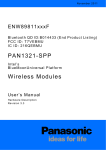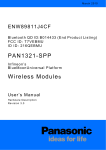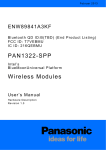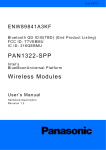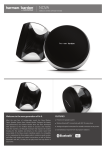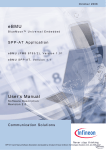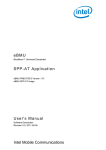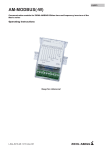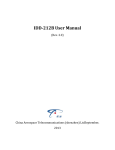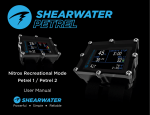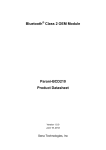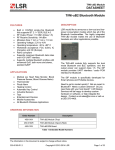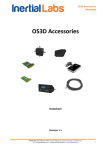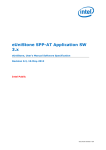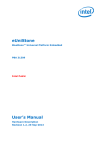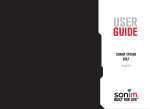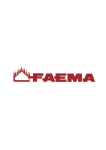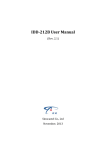Download PAN1321 Specification
Transcript
October 2011 ENW89811K4CF Bluetooth QD ID:B014433 (End Product Listing) FCC ID: T7VEBMU IC ID: 216QEBMU PAN1321-SPP In f i n e o n’s BlueMoonUniversal Platform Wireless Modules User’s Manual Hardware Description Revision 3.2 Edition 2011-10-17 Published by Panasonic Electronic Devices Europe GmbH Zeppelinstrasse 19 D-21337 Lüneburg, Germany © 2011 Panasonic Electronic Devices Europe GmbH All Rights Reserved. Legal Disclaimer The information given in this document shall in no event be regarded as a guarantee of conditions or characteristics. With respect to any examples or hints given herein, any typical values stated herein and/or any information regarding the application of the device, Infineon Technologies hereby disclaims any and all warranties and liabilities of any kind, including without limitation, warranties of non-infringement of intellectual property rights of any third party. Information For further information on technology, delivery terms and conditions and prices please contact your nearest Panasonic Office in Germany or one of our Distributor or write an e-mail to [email protected]. Warnings Due to technical requirements components may contain dangerous substances. For information on the types in question please contact your nearest Panasonic Office. Panasonic Electronic Devices may only be used in life-support devices or systems with the express written approval of Panasonic Devices, if a failure of such components can reasonably be expected to cause the failure of that life-support device or system, or to affect the safety or effectiveness of that device or system. Life support devices or systems are intended to be implanted in the human body, or to support and/or maintain and sustain and/or protect human life. If they fail, it is reasonable to assume that the health of the user or other persons may be endangered. PAN1321-SPP ENW89811K4CF ENW89811K4CF 22/xx - Infinion’s BlueMoonTM Universal Platform Revision History: 2011-10-17, Revision 3.2 Previous Version: 3.1 Page Subjects (major changes since last revision) Rev1.0 Initial version Rev2.0 Due to better range with another ceramic antenna, we have updated module height from 1.8mm to 2.8mm. Changes made in “Production Package” on Page 28 If you need smaller height, let us discuss your individual case. Rev3.0 Releasing this document and correct the ordering code to ENW89811K4CF, which is the 85°C version Rev3.1 Add the Chapter 8, Modified Figure 5 “Package Marking” on Page 28 and Figure 7 “Top View and Bottom View” on Page 29 Rev3.2 Fixed all pins for the product life time in Chapter 1.4. Added Table 2 “Firmware Releases as of 2011-10-17” on Page 13 and updated the Chapter 11. Trademarks of Infineon Technologies AG, used in this document BlueMoon™ User’s Manual Hardware Description 3 Revision 3.2, 2011-10-17 PAN1321-SPP ENW89811K4CF Table of Contents Table of Contents Table of Contents . . . . . . . . . . . . . . . . . . . . . . . . . . . . . . . . . . . . . . . . . . . . . . . . . . . . . . . . . . . . . . . . 4 List of Figures . . . . . . . . . . . . . . . . . . . . . . . . . . . . . . . . . . . . . . . . . . . . . . . . . . . . . . . . . . . . . . . . . . . 6 List of Tables . . . . . . . . . . . . . . . . . . . . . . . . . . . . . . . . . . . . . . . . . . . . . . . . . . . . . . . . . . . . . . . . . . . . 7 1 1.1 1.2 1.3 1.4 1.5 1.6 General Device Overview . . . . . . . . . . . . . . . . . . . . . . . . . . . . . . . . . . . . . . . . . . . . . . . . . . . . . . . . . . 8 Features . . . . . . . . . . . . . . . . . . . . . . . . . . . . . . . . . . . . . . . . . . . . . . . . . . . . . . . . . . . . . . . . . . . . . . . . 8 Block Diagram . . . . . . . . . . . . . . . . . . . . . . . . . . . . . . . . . . . . . . . . . . . . . . . . . . . . . . . . . . . . . . . . . . . 9 Pin Configuration LGA . . . . . . . . . . . . . . . . . . . . . . . . . . . . . . . . . . . . . . . . . . . . . . . . . . . . . . . . . . . . . 9 Pin Description . . . . . . . . . . . . . . . . . . . . . . . . . . . . . . . . . . . . . . . . . . . . . . . . . . . . . . . . . . . . . . . . . . 10 System Integration . . . . . . . . . . . . . . . . . . . . . . . . . . . . . . . . . . . . . . . . . . . . . . . . . . . . . . . . . . . . . . . 12 FW version . . . . . . . . . . . . . . . . . . . . . . . . . . . . . . . . . . . . . . . . . . . . . . . . . . . . . . . . . . . . . . . . . . . . . 13 2 2.1 2.2 Basic Operating Information . . . . . . . . . . . . . . . . . . . . . . . . . . . . . . . . . . . . . . . . . . . . . . . . . . . . . . 14 Power Supply . . . . . . . . . . . . . . . . . . . . . . . . . . . . . . . . . . . . . . . . . . . . . . . . . . . . . . . . . . . . . . . . . . . 14 Clocking . . . . . . . . . . . . . . . . . . . . . . . . . . . . . . . . . . . . . . . . . . . . . . . . . . . . . . . . . . . . . . . . . . . . . . . 14 3 3.1 3.1.1 3.1.1.1 Interfaces . . . . . . . . . . . . . . . . . . . . . . . . . . . . . . . . . . . . . . . . . . . . . . . . . . . . . . . . . . . . . . . . . . . . . . UART Interface . . . . . . . . . . . . . . . . . . . . . . . . . . . . . . . . . . . . . . . . . . . . . . . . . . . . . . . . . . . . . . . . . . UART . . . . . . . . . . . . . . . . . . . . . . . . . . . . . . . . . . . . . . . . . . . . . . . . . . . . . . . . . . . . . . . . . . . . . . . . Baud Rates . . . . . . . . . . . . . . . . . . . . . . . . . . . . . . . . . . . . . . . . . . . . . . . . . . . . . . . . . . . . . . . . . 15 15 15 15 4 4.1 4.2 4.2.1 General Device Capabilities . . . . . . . . . . . . . . . . . . . . . . . . . . . . . . . . . . . . . . . . . . . . . . . . . . . . . . . HCI+ . . . . . . . . . . . . . . . . . . . . . . . . . . . . . . . . . . . . . . . . . . . . . . . . . . . . . . . . . . . . . . . . . . . . . . . . . . Firmware ROM Patching . . . . . . . . . . . . . . . . . . . . . . . . . . . . . . . . . . . . . . . . . . . . . . . . . . . . . . . . . . Patch Support . . . . . . . . . . . . . . . . . . . . . . . . . . . . . . . . . . . . . . . . . . . . . . . . . . . . . . . . . . . . . . . . . 16 16 16 16 5 5.1 5.2 5.2.1 5.2.1.1 5.2.1.2 5.2.1.3 5.2.1.4 5.2.2 5.2.2.1 5.2.2.2 5.2.2.3 Bluetooth Capabilities . . . . . . . . . . . . . . . . . . . . . . . . . . . . . . . . . . . . . . . . . . . . . . . . . . . . . . . . . . . Supported Features . . . . . . . . . . . . . . . . . . . . . . . . . . . . . . . . . . . . . . . . . . . . . . . . . . . . . . . . . . . . . . PAN1321-SPP Specifics and Extensions . . . . . . . . . . . . . . . . . . . . . . . . . . . . . . . . . . . . . . . . . . . . . . During Connection . . . . . . . . . . . . . . . . . . . . . . . . . . . . . . . . . . . . . . . . . . . . . . . . . . . . . . . . . . . . . . Role Switch . . . . . . . . . . . . . . . . . . . . . . . . . . . . . . . . . . . . . . . . . . . . . . . . . . . . . . . . . . . . . . . . . Dynamic Polling Strategy . . . . . . . . . . . . . . . . . . . . . . . . . . . . . . . . . . . . . . . . . . . . . . . . . . . . . . . Adaptive Frequency Hopping (AFH) . . . . . . . . . . . . . . . . . . . . . . . . . . . . . . . . . . . . . . . . . . . . . . Channel Quality Driven Data Rate Change (CQDDR) . . . . . . . . . . . . . . . . . . . . . . . . . . . . . . . . RSSI and Output Power Control . . . . . . . . . . . . . . . . . . . . . . . . . . . . . . . . . . . . . . . . . . . . . . . . . . . Received Signal Strength Indication (RSSI) . . . . . . . . . . . . . . . . . . . . . . . . . . . . . . . . . . . . . . . . Output Power Control . . . . . . . . . . . . . . . . . . . . . . . . . . . . . . . . . . . . . . . . . . . . . . . . . . . . . . . . . Ultra Low Transmit Power . . . . . . . . . . . . . . . . . . . . . . . . . . . . . . . . . . . . . . . . . . . . . . . . . . . . . . 17 17 18 18 18 18 18 18 19 19 19 19 6 6.1 6.2 6.3 6.3.1 6.3.2 6.3.3 6.3.4 6.4 6.5 6.5.1 6.5.1.1 Electrical Characteristics . . . . . . . . . . . . . . . . . . . . . . . . . . . . . . . . . . . . . . . . . . . . . . . . . . . . . . . . . Absolute Maximum Ratings . . . . . . . . . . . . . . . . . . . . . . . . . . . . . . . . . . . . . . . . . . . . . . . . . . . . . . . . Operating Conditions . . . . . . . . . . . . . . . . . . . . . . . . . . . . . . . . . . . . . . . . . . . . . . . . . . . . . . . . . . . . . DC Characteristics . . . . . . . . . . . . . . . . . . . . . . . . . . . . . . . . . . . . . . . . . . . . . . . . . . . . . . . . . . . . . . . Pad Driver and Input Stages . . . . . . . . . . . . . . . . . . . . . . . . . . . . . . . . . . . . . . . . . . . . . . . . . . . . . . Pull-ups and Pull-downs . . . . . . . . . . . . . . . . . . . . . . . . . . . . . . . . . . . . . . . . . . . . . . . . . . . . . . . . . Protection Circuits . . . . . . . . . . . . . . . . . . . . . . . . . . . . . . . . . . . . . . . . . . . . . . . . . . . . . . . . . . . . . . System Power Consumption . . . . . . . . . . . . . . . . . . . . . . . . . . . . . . . . . . . . . . . . . . . . . . . . . . . . . . AC Characteristics . . . . . . . . . . . . . . . . . . . . . . . . . . . . . . . . . . . . . . . . . . . . . . . . . . . . . . . . . . . . . . . RF Part . . . . . . . . . . . . . . . . . . . . . . . . . . . . . . . . . . . . . . . . . . . . . . . . . . . . . . . . . . . . . . . . . . . . . . . . Characteristics RF Part . . . . . . . . . . . . . . . . . . . . . . . . . . . . . . . . . . . . . . . . . . . . . . . . . . . . . . . . . . Bluetooth Related Specifications . . . . . . . . . . . . . . . . . . . . . . . . . . . . . . . . . . . . . . . . . . . . . . . . . 20 20 20 21 21 23 23 24 24 24 24 24 User’s Manual Hardware Description 4 Revision 3.2, 2011-10-17 PAN1321-SPP ENW89811K4CF Table of Contents 7 7.1 7.2 7.2.1 Package Information . . . . . . . . . . . . . . . . . . . . . . . . . . . . . . . . . . . . . . . . . . . . . . . . . . . . . . . . . . . . Package Marking . . . . . . . . . . . . . . . . . . . . . . . . . . . . . . . . . . . . . . . . . . . . . . . . . . . . . . . . . . . . . . . . Production Package . . . . . . . . . . . . . . . . . . . . . . . . . . . . . . . . . . . . . . . . . . . . . . . . . . . . . . . . . . . . . . Pin Mark . . . . . . . . . . . . . . . . . . . . . . . . . . . . . . . . . . . . . . . . . . . . . . . . . . . . . . . . . . . . . . . . . . . . . . 28 28 28 29 8 8.1 8.2 8.3 8.4 8.5 8.6 8.7 8.8 8.9 8.10 Important Application Information . . . . . . . . . . . . . . . . . . . . . . . . . . . . . . . . . . . . . . . . . . . . . . . . . Reference Design . . . . . . . . . . . . . . . . . . . . . . . . . . . . . . . . . . . . . . . . . . . . . . . . . . . . . . . . . . . . . . . . FCC Class B Digital Devices Regulatory Notice . . . . . . . . . . . . . . . . . . . . . . . . . . . . . . . . . . . . . . . . . FCC Wireless Notice . . . . . . . . . . . . . . . . . . . . . . . . . . . . . . . . . . . . . . . . . . . . . . . . . . . . . . . . . . . . . FCC Interference Statement . . . . . . . . . . . . . . . . . . . . . . . . . . . . . . . . . . . . . . . . . . . . . . . . . . . . . . . . FCC Identifier . . . . . . . . . . . . . . . . . . . . . . . . . . . . . . . . . . . . . . . . . . . . . . . . . . . . . . . . . . . . . . . . . . . European R&TTE Declaration of Conformity . . . . . . . . . . . . . . . . . . . . . . . . . . . . . . . . . . . . . . . . . . . Bluetooth Qualified Design ID . . . . . . . . . . . . . . . . . . . . . . . . . . . . . . . . . . . . . . . . . . . . . . . . . . . . . . . Industry Canada Certification . . . . . . . . . . . . . . . . . . . . . . . . . . . . . . . . . . . . . . . . . . . . . . . . . . . . . . . Label Design of the Host Product . . . . . . . . . . . . . . . . . . . . . . . . . . . . . . . . . . . . . . . . . . . . . . . . . . . . Regulatory Test House . . . . . . . . . . . . . . . . . . . . . . . . . . . . . . . . . . . . . . . . . . . . . . . . . . . . . . . . . . . . 30 30 31 31 32 32 32 34 34 34 34 9 9.1 9.2 9.3 9.4 9.4.1 9.4.2 9.4.3 9.5 9.6 9.6.1 9.6.2 9.6.2.1 9.6.2.2 9.7 9.8 9.9 9.9.1 9.9.2 Assembly Guidelines . . . . . . . . . . . . . . . . . . . . . . . . . . . . . . . . . . . . . . . . . . . . . . . . . . . . . . . . . . . . General Description of the Module . . . . . . . . . . . . . . . . . . . . . . . . . . . . . . . . . . . . . . . . . . . . . . . . . . . Printed Circuit Board Design . . . . . . . . . . . . . . . . . . . . . . . . . . . . . . . . . . . . . . . . . . . . . . . . . . . . . . . Solder Paste Printing . . . . . . . . . . . . . . . . . . . . . . . . . . . . . . . . . . . . . . . . . . . . . . . . . . . . . . . . . . . . . Assembly . . . . . . . . . . . . . . . . . . . . . . . . . . . . . . . . . . . . . . . . . . . . . . . . . . . . . . . . . . . . . . . . . . . . . . Component Placement . . . . . . . . . . . . . . . . . . . . . . . . . . . . . . . . . . . . . . . . . . . . . . . . . . . . . . . . . . Pin Mark . . . . . . . . . . . . . . . . . . . . . . . . . . . . . . . . . . . . . . . . . . . . . . . . . . . . . . . . . . . . . . . . . . . . . . Package . . . . . . . . . . . . . . . . . . . . . . . . . . . . . . . . . . . . . . . . . . . . . . . . . . . . . . . . . . . . . . . . . . . . . . Soldering Profile . . . . . . . . . . . . . . . . . . . . . . . . . . . . . . . . . . . . . . . . . . . . . . . . . . . . . . . . . . . . . . . . . Rework . . . . . . . . . . . . . . . . . . . . . . . . . . . . . . . . . . . . . . . . . . . . . . . . . . . . . . . . . . . . . . . . . . . . . . . . Removal Procedure . . . . . . . . . . . . . . . . . . . . . . . . . . . . . . . . . . . . . . . . . . . . . . . . . . . . . . . . . . . . Replacement Procedure . . . . . . . . . . . . . . . . . . . . . . . . . . . . . . . . . . . . . . . . . . . . . . . . . . . . . . . . . Alternative 1: Dispensing Solder . . . . . . . . . . . . . . . . . . . . . . . . . . . . . . . . . . . . . . . . . . . . . . . . . Alternative 2: Printing Solder . . . . . . . . . . . . . . . . . . . . . . . . . . . . . . . . . . . . . . . . . . . . . . . . . . . . Inspection . . . . . . . . . . . . . . . . . . . . . . . . . . . . . . . . . . . . . . . . . . . . . . . . . . . . . . . . . . . . . . . . . . . . . . Component Salvage . . . . . . . . . . . . . . . . . . . . . . . . . . . . . . . . . . . . . . . . . . . . . . . . . . . . . . . . . . . . . . Voids in the Solder Joints . . . . . . . . . . . . . . . . . . . . . . . . . . . . . . . . . . . . . . . . . . . . . . . . . . . . . . . . . . Expected Void Content and Reliability . . . . . . . . . . . . . . . . . . . . . . . . . . . . . . . . . . . . . . . . . . . . . . . Parameters with an Impact on Voiding . . . . . . . . . . . . . . . . . . . . . . . . . . . . . . . . . . . . . . . . . . . . . . 35 35 35 35 36 36 36 37 38 39 39 39 39 40 40 40 41 41 41 10 Terminology . . . . . . . . . . . . . . . . . . . . . . . . . . . . . . . . . . . . . . . . . . . . . . . . . . . . . . . . . . . . . . . . . . . 43 11 References . . . . . . . . . . . . . . . . . . . . . . . . . . . . . . . . . . . . . . . . . . . . . . . . . . . . . . . . . . . . . . . . . . . . 47 User’s Manual Hardware Description 5 Revision 3.2, 2011-10-17 PAN1321-SPP ENW89811K4CF List of Figures List of Figures Figure 1 Figure 2 Figure 3 Figure 4 Figure 5 Figure 6 Figure 7 Figure 8 Figure 9 Figure 10 Figure 11 Figure 12 Figure 13 Figure 14 Figure 15 Figure 16 Figure 17 Simplified Block Diagram of PAN1321-SPP . . . . . . . . . . . . . . . . . . . . . . . . . . . . . . . . . . . . . . . . . . . 9 Pin Configuration for PAN1321-SPP in Top View (footprint) . . . . . . . . . . . . . . . . . . . . . . . . . . . . . . 9 Example of a Bluetooth System using eUniStone . . . . . . . . . . . . . . . . . . . . . . . . . . . . . . . . . . . . . 12 UART Interface . . . . . . . . . . . . . . . . . . . . . . . . . . . . . . . . . . . . . . . . . . . . . . . . . . . . . . . . . . . . . . . . 15 Package Marking . . . . . . . . . . . . . . . . . . . . . . . . . . . . . . . . . . . . . . . . . . . . . . . . . . . . . . . . . . . . . . 28 Production Package . . . . . . . . . . . . . . . . . . . . . . . . . . . . . . . . . . . . . . . . . . . . . . . . . . . . . . . . . . . . 28 Top View and Bottom View. . . . . . . . . . . . . . . . . . . . . . . . . . . . . . . . . . . . . . . . . . . . . . . . . . . . . . . 29 Reference Design Schematics . . . . . . . . . . . . . . . . . . . . . . . . . . . . . . . . . . . . . . . . . . . . . . . . . . . . 30 Equipment Label. . . . . . . . . . . . . . . . . . . . . . . . . . . . . . . . . . . . . . . . . . . . . . . . . . . . . . . . . . . . . . . 32 Declaration of Conformity . . . . . . . . . . . . . . . . . . . . . . . . . . . . . . . . . . . . . . . . . . . . . . . . . . . . . . . . 33 Pad Layout on the Module (top view) . . . . . . . . . . . . . . . . . . . . . . . . . . . . . . . . . . . . . . . . . . . . . . . 35 Pin Marking. . . . . . . . . . . . . . . . . . . . . . . . . . . . . . . . . . . . . . . . . . . . . . . . . . . . . . . . . . . . . . . . . . . 36 Tape on Reel . . . . . . . . . . . . . . . . . . . . . . . . . . . . . . . . . . . . . . . . . . . . . . . . . . . . . . . . . . . . . . . . . 37 Eutectic Lead-Solder Profile . . . . . . . . . . . . . . . . . . . . . . . . . . . . . . . . . . . . . . . . . . . . . . . . . . . . . . 38 Eutectic Leadfree-Solder Profile . . . . . . . . . . . . . . . . . . . . . . . . . . . . . . . . . . . . . . . . . . . . . . . . . . . 38 Solder Printing . . . . . . . . . . . . . . . . . . . . . . . . . . . . . . . . . . . . . . . . . . . . . . . . . . . . . . . . . . . . . . . . 40 X-ray Picture Showing Voids Conforming to IPC-A-610D . . . . . . . . . . . . . . . . . . . . . . . . . . . . . . . 41 User’s Manual Hardware Description 6 Revision 3.2, 2011-10-17 PAN1321-SPP ENW89811K4CF List of Tables List of Tables Table 1 Table 2 Table 3 Table 4 Table 5 Table 6 Table 7 Table 8 Table 9 Table 10 Table 11 Table 12 Table 13 Table 14 Table 15 Table 16 Table 17 Pin Description . . . . . . . . . . . . . . . . . . . . . . . . . . . . . . . . . . . . . . . . . . . . . . . . . . . . . . . . . . . . . . . . Firmware Releases as of 2011-10-17. . . . . . . . . . . . . . . . . . . . . . . . . . . . . . . . . . . . . . . . . . . . . . . UART Baud Rates . . . . . . . . . . . . . . . . . . . . . . . . . . . . . . . . . . . . . . . . . . . . . . . . . . . . . . . . . . . . . Absolute Maximum Ratings . . . . . . . . . . . . . . . . . . . . . . . . . . . . . . . . . . . . . . . . . . . . . . . . . . . . . . Operating Conditions . . . . . . . . . . . . . . . . . . . . . . . . . . . . . . . . . . . . . . . . . . . . . . . . . . . . . . . . . . . Internal1 (1.5 V) Supplied Pins . . . . . . . . . . . . . . . . . . . . . . . . . . . . . . . . . . . . . . . . . . . . . . . . . . . Internal2 (2.5 V) Supplied Pins . . . . . . . . . . . . . . . . . . . . . . . . . . . . . . . . . . . . . . . . . . . . . . . . . . . VDDUART Supplied Pins . . . . . . . . . . . . . . . . . . . . . . . . . . . . . . . . . . . . . . . . . . . . . . . . . . . . . . . VDD1 Supplied Pins . . . . . . . . . . . . . . . . . . . . . . . . . . . . . . . . . . . . . . . . . . . . . . . . . . . . . . . . . . . ONOFF PIN . . . . . . . . . . . . . . . . . . . . . . . . . . . . . . . . . . . . . . . . . . . . . . . . . . . . . . . . . . . . . . . . . . Pull-up and Pull-down Currents . . . . . . . . . . . . . . . . . . . . . . . . . . . . . . . . . . . . . . . . . . . . . . . . . . . Max. Load at the Different Supply Voltages . . . . . . . . . . . . . . . . . . . . . . . . . . . . . . . . . . . . . . . . . BDR - Transmitter Part . . . . . . . . . . . . . . . . . . . . . . . . . . . . . . . . . . . . . . . . . . . . . . . . . . . . . . . . . BDR -Receiver Part . . . . . . . . . . . . . . . . . . . . . . . . . . . . . . . . . . . . . . . . . . . . . . . . . . . . . . . . . . . . EDR - Transmitter Part . . . . . . . . . . . . . . . . . . . . . . . . . . . . . . . . . . . . . . . . . . . . . . . . . . . . . . . . . EDR -Receiver Part . . . . . . . . . . . . . . . . . . . . . . . . . . . . . . . . . . . . . . . . . . . . . . . . . . . . . . . . . . . . Antennas. . . . . . . . . . . . . . . . . . . . . . . . . . . . . . . . . . . . . . . . . . . . . . . . . . . . . . . . . . . . . . . . . . . . . User’s Manual Hardware Description 7 10 13 15 20 20 21 21 21 22 22 23 24 24 25 26 26 31 Revision 3.2, 2011-10-17 PAN1321-SPP ENW89811K4CF General Device Overview 1 General Device Overview 1.1 Features General • • • • • • • • • Complete Bluetooth 2.0 + EDR solution – Configurable for BT 1.2 Ultra low power design in 0.13 μm CMOS Temperature range from -40°C to 85°C Integrates ARM7TDMI, RAM and patchable ROM On-module voltage regulators. External supply 2.9 - 4.1 V On-module EEPROM with configuration data Reference clock included Low power clock from internal oscillator or external low power clock (e.g. 32.768 kHz) Dynamic low power mode switching Interfaces • • AT command interface over UART, configurable from 9600 baud up to 3.25 MBaud General purpose I/Os with interrupt capabilities. JTAG for boundary scan and debug RF • • • • • • Transmit power typ. 2.5 dBm (default settings) Receiver sensitivity typ. -86 dBm Integrated antenna switch, balun and antenna filter Integrated LNA with excellent blocking and intermodulation performance No external components except antenna Digital demodulation for optimum sensitivity and co-/adjacent channel performance Bluetooth • • • • • • • • • • • • • Bluetooth V2.0 + EDR compliant SPP Device A and B support 1 ACL link with stream or command mode SPP Device A and B - Visible while connected SPP Device A and B - Visible/connectable when not connected SPP Device A and B - Device Discovery capable after receiving OK on data transfer Sniff mode is supported with above capabilities 5 trusted devices stored in EEPROM Testing Enable DUT Crystal calibration H4 with UART HW flow control (RTS/CTS) Security modes: Modes 1 and Mode 3 Master-Slave role switch User’s Manual Hardware Description 8 Revision 3.2, 2011-10-17 PAN1321-SPP ENW89811K4CF General Device Overview 1.2 Block Diagram PAN1321-SPP EEPROM Ceramic Antenna VDD1 I2C VDD_UART UART PMB8753/2 BlueMoon UniCellular GPIO V supply Balun Filter / Matching Voltage Regulator Crystal 26 MHz PAN1321 _ Block_ Diagram.vsd Figure 1 Simplified Block Diagram of PAN1321-SPP 1.3 Pin Configuration LGA 15.6 mm 5.0 1.2 F2 F3 F4 F5 F6 F7 F8 F9 E1 E2 E3 E4 E5 E6 E7 E8 E9 D1 D2 D3 D4 D5 D6 D7 D8 D9 C1 C2 C3 C4 C5 C6 C7 C8 C9 B1 B2 B3 B4 B5 B6 B7 B8 B9 A1 A2 A3 A4 A5 A6 A7 A8 A9 1.35 1.2 F1 8.70 mm 0.6 1.35 1.0 0.6 Figure 2 Pin Configuration for PAN1321-SPP in Top View (footprint) User’s Manual Hardware Description 9 Revision 3.2, 2011-10-17 PAN1321-SPP ENW89811K4CF General Device Overview 1.4 Pin Description All mentioned pins are fix for the product lifetime. Pins not listed below shall not be connected. Table 1 Pin Description Pin No. Symbol Input / Output Supply Voltage During Reset After Reset Function A2 P1.6 I/O/OD Internal1 Z Z Port 1.6 A3 RESET# AI Internal1 Input Input Hardware Reset, active low A8 P1.5 I/O/OD Internal1 Input Input Port 1.5 B1 P1.7 I/O/OD Internal1 PD/ Input PD/ Input Port 1.7 B2 P1.8 I/O/OD Internal1 PD PD Port 1.8 1) PU 1) Port 1.0 or JTAG interface B3 P1.0 / TMS I/O/OD Internal2 PU B4 P1.4 / RTCK I/O/OD Internal2 Z Z Port 1.4 or JTAG interface B5 ONOFF I - - Connect to VDD1 and refer to chapter 11 item [3]. B9 SLEEPX I/O VDDUART PD H Sleep indication signal C2 P0.9 I/O/OD Internal2 Z Z Port 0.9 C3 JTAG# I Internal2 PU PU Mode selection Port 1: 0: JTAG 1: Port C4 TRST# I Internal2 PD PD JTAG interface D1 P0.10 I/O/OD Internal2 Z Z Port 0.10 D2 P0.8 I/O/OD Internal2 PD PD 1) PU Port 0.8 1) Port 1.1 or JTAG interface D3 P1.1 / TCK I/O/OD Internal2 PU D4 P0.3 I/O/OD VDD1 Conf. PD def. Conf. PD def. Port 0.3 D5 P0.2 I/O/OD VDD1 Z Z Port 0.2 E1 P0.12 / SDA0 I/O/OD Internal2 PU PU I2C data signal E2 P0.13 / SCL0 I/O/OD Internal2 PU PU I2C clock signal E3 P1.3 / TDO I/O/OD Internal2 Z Z Port 1.3 or JTAG interface E4 P0.0 I/O/OD VDD1 PD PD Port 0.0 LPM wakeup output E5 P0.1 I/O/OD VDD1 PD PD Port 0.1 E6 P0.5 / UARTRXD I/O/OD VDDUART Z Z Port 0.5 or UART receive data F2 P1.2 / TDI I/O/OD Internal2 PU1) PU1) Port 1.2 or JTAG interface F3 P0.11 I/O/OD Internal2 Z Z Port 0.11 User’s Manual Hardware Description 10 Revision 3.2, 2011-10-17 PAN1321-SPP ENW89811K4CF General Device Overview Table 1 Pin Description Pin No. Symbol Input / Output Supply Voltage During Reset After Reset Function F4 P0.14 I/O VDDUART Z Z Port 0.14 LPM wakup input F5 P0.7 / UARTCTS I/O/OD VDDUART Z Z Port 0.7 or UART CTS flow control F7 P0.4 / UARTTXD I/O/OD VDDUART PU PU Port 0.4 or UART transmit data F8 P0.6 / UARTRTS I/O/OD VDDUART PU PU Port 0.6 or UART RTS flow control A4, A5, A6 VSUPPLY SI - - Power supply C1 VREG SO - - Regulated Power supply F6 VDDUART SI - - UART interface Power supply C5 VDD1 SI - - Power supply A1, A7, A9, C8, C9, D7, D8, E8, E9, F1, F9 VSS - - Ground 1) Fixed pull-up/pull-down if JTAG interface is selected, not affected by any chip reset. If JTAG interface is not selected the port is tristate. Descriptions of acronyms used in the pin list: Acronym Description I Input O Output OD Output with open drain capability Z Tristate PU Pull-up PD Pull-down A Analog (e.g. AI means analog input) S Supply (e.g. SO means supply output) User’s Manual Hardware Description 11 Revision 3.2, 2011-10-17 PAN1321-SPP ENW89811K4CF General Device Overview 1.5 System Integration PAN1321-SPP is optimized for a low bill of material (BOM) and a small PCB size. Figure 3 shows a typical application example. HOST Keys, Leds UART RESET AT command interface GPIO SPP(Serial Port Profile ) Loaded from EEPROM Oscillator API RFCOMM EEPROM I2 C BT Stack BT Baseband Voltage BT RF Regulator BALUN Antenna VSUPPLY Example _Application_ PAN1311 .vsd Figure 3 Example of a Bluetooth System using eUniStone User’s Manual Hardware Description 12 Revision 3.2, 2011-10-17 PAN1321-SPP ENW89811K4CF General Device Overview The UART interface is used for communication between the host and PAN1321-SPP. The lines UARTTXD and UARTRXD are used for commands, events and data. The lines UARTRTS and UARTCTS are used for hardware flow control. Low power mode control of PAN1321-SPP and the host can be implemented in by using the pins P0.14 and P0.0. P0.14 is used by the host to allow PAN1321-SPP to enter low power mode and P0.0 is used by PAN1321-SPP to wake-up the host when attention is required. Additionally, the host could hardware reset PAN1321-SPP using the RESET# pin. Power is supplied to a single VSUPPLY input from which internal regulators can generate all required voltages. The UART and the GPIO’s interfaces have separate supply voltages so that they can comply with host signaling. 1.6 FW version PAN1321-SPP is available in different firmware (FW) versions. Please check corresponding release documents for latest information in chapter 11 item [1]. The identifier about the software version will be visible on the module, please refer to Figure 5, here it is the identifier SW. There are actual 4 different firmware releases available in Table 2 Table 2 Firmware Releases as of 2011-10-17 SW FW (marking on (firmware the module) version) Comment 07 1.6 first standard release, free of charge 08 1.8 second standard release, free of charge, should be used for new projects 20 2.0 first iPhone release, special license fee is needed 21 2.1 second iPhone release, special license fee is needed, should be used for new projects User’s Manual Hardware Description 13 Revision 3.2, 2011-10-17 PAN1321-SPP ENW89811K4CF Basic Operating Information 2 Basic Operating Information 2.1 Power Supply PAN1321-SPP is supplied from a single supply voltage VSUPPLY. This supply voltage must always be present. The PAN1321-SPP chip is supplied from an internally generated 2.5 V supply voltage. This voltage can be accessed from the VREG pin. This voltage may not be used for supplying other components in the host system but can be used for referencing the host interfaces. The GPIO’s and the UART interface are supplied with dedicated, independent, reference levels via the VDD1 and VDDUART pins. All other digital I/O pins are supplied internally by either 2.5 V (Internal2) or 1.5 V (Internal1). Section 1.4 provides a mapping between pins and supply voltages. The I/O power domains (VDD1 and VDDUART) are completely separated from the other power domains and can stay present also in low power modes. 2.2 Clocking PAN1321-SPP contains a crystal from which the internal 26 MHz system clock is generated. Also, the low power mode clock of 32 kHz is generated internally, which means that no external clock is needed. User’s Manual Hardware Description 14 Revision 3.2, 2011-10-17 PAN1321-SPP ENW89811K4CF Interfaces 3 Interfaces 3.1 UART Interface The UART interface is the main communication interface between the host and PAN1321-SPP. The interface consists of four UART signals and two wake-up signals as shown in Figure 4. Host UARTTXD UARTRXD UARTRTS UARTCTS UARTTXD UARTRXD UARTRTS UARTCTS WAKEUP_BT WAKEUP_HOST Figure 4 UART Interface 3.1.1 UART PAN1321 P0.14 input P0.0 output The UART (Universal Asynchronous Receiver and Transmitter) interface is compatible with standard UART H4 (4-wire). The lines UARTTXD and UARTRXD are used for commands, events and data. The lines UARTRTS and UARTCTS are used for hardware flow control. A separate supply voltage, VDDUART, makes it easy to connect the UART interface to any system. 3.1.1.1 Baud Rates The supported baud rates are listed in Table 3 together with the small deviation error that results from the internal clock generation. The default baud rate is 115200 Baud. Table 3 UART Baud Rates Wanted Baud Rate Real Baud Rate Deviation Error (%) 9600 9615 0.16 19200 19230 0.16 38400 38461 0.16 57600 57522 -0.14 115200 115044 -0.14 230400 230088 -0.14 460800 464285 0.76 921600 928571 0.76 1843200 1857142 0.76 3250000 3250000 0 User’s Manual Hardware Description 15 Revision 3.2, 2011-10-17 PAN1321-SPP ENW89811K4CF General Device Capabilities 4 General Device Capabilities This chapter describes features available in the PAN1321 (ENW89811K4CF 22/xx) core. Actual feature set and how to access the features can be found in the AT Command document [1]. Release specific performance characteristics, like data speed, is related in the SW Release Notes [2]. 4.1 HCI+ The PAN1321 module can be programmed over UART with a specific application for RF test purposes, like TX continuous or TX burst mode. This test application is controlled over the UART through Infineon specific HCI commands. The commands supported by this test application are described in the document “T8753-2Infineon_Specific_HCI_Commands-7600.pdf”. 4.2 Firmware ROM Patching 4.2.1 Patch Support PAN1321-SPP contains dedicated hardware that makes it possible to apply patches to the code and data in the firmware ROM. The hardware is capable of replacing up to 32 blocks of 16 bytes each with new content. This area can be filled with any combination of code and data. The firmware patch is stored in EEPROM and automatically loaded after startup. This provides a flexible bugfix solution for the ROM part of the firmware. User’s Manual Hardware Description 16 Revision 3.2, 2011-10-17 PAN1321-SPP ENW89811K4CF Bluetooth Capabilities 5 Bluetooth Capabilities 5.1 Supported Features • • • • • • • • • • • • • • • • • • • • • • • Bluetooth V2.0 + EDR compliant Enhanced Data Rate up to 3 Mbit/s Adaptive Frequency Hopping (AFH) All packet types Authentication, Pairing and Encryption SPP Device A and B support 1 ACL link with stream or command mode SPP Device A and B - Visible while connected SPP Device A and B - Visible/connectable when not connected SPP Device A and B - Device Discovery capable after receiving OK on data transfer Sniff mode is supported with above capabilities 5 trusted devices stored in EEPROM Enable DUT Crystal calibration H4 with UART HW flow control (RTS/CTS) Security modes: Modes 1 and Mode 3 Master-Slave role switch Quality of Service Channel Quality Driven Data Rate change Sniff, Hold Role Switch RSSI and Power Control Power class 2 and 3 Standard Bluetooth test mode, Active Tester Mode and RF Test Modes User’s Manual Hardware Description 17 Revision 3.2, 2011-10-17 PAN1321-SPP ENW89811K4CF Bluetooth Capabilities 5.2 PAN1321-SPP Specifics and Extensions 5.2.1 During Connection 5.2.1.1 Role Switch Only one role switch can be performed at a time. If a role switch request is pending, other role switch requests on the same or other links are rejected. If a role switch fails, PAN1321-SPP will automatically try again a maximum of three times. Encryption (if present) is stopped in the old piconet before a role switch is performed and re-enabled when the role switch has succeeded or failed. 5.2.1.2 Dynamic Polling Strategy In addition to the regular polling scheme, PAN1321-SPP dynamically assigns unused slots to links where data is exchanged. This adapts very well to bursty traffic and improves throughput and latency on the links. 5.2.1.3 Adaptive Frequency Hopping (AFH) PAN1321-SPP supports adaptive frequency hopping according to the Bluetooth 2.0 + EDR specification. AFH switch and channel classification are supported both as master and slave. Channel classification from the host is also supported. A number of HCI+ commands and events are available to provide information about AFH operation. The commands Infineon_Enable_AFH_Info_Sending and Infineon_Disable_AFH_Info_Sending turn on and off the Infineon AFH Info events that provide detailed information about channel classification, channel maps, interferers, etc. If enabled by the Infineon_Enable_Infineon_Events command, the Infineon AFH Extraordinary RSSI event informs the host whenever extraordinary RSSI measurements in unused slots have been started. This is done when the number of known good channels has decreased below a critical limit and periodically after a defined time. The Infineon_Set_AFH_Measurement_Period command can be used to configure the duration of the AFH measurement period. 5.2.1.4 Channel Quality Driven Data Rate Change (CQDDR) PAN1321-SPP supports channel quality driven data rate change according to the Bluetooth 2.0 + EDR specification. A device that receives an LMP_preferred_rate message is not required to follow all recommendations. PAN1321-SPP normally at least follows the recommendation whether to use forward error correction (FEC) or not. If possible, recommendations about packet size and modulation scheme will be taken into account. When PAN1321-SPP sends an LMP_preferred_rate to another device the proposal always includes preferences for all parameters. The HCI+ commands Infineon_Enable_CQDDR_Info_Sending and Infineon_Disable_CQDDR_Info_Sending turn on and off sending of the Infineon CQDDR Info event. This event provides information to the host every time a new CQDDR proposal is sent to a remote device. User’s Manual Hardware Description 18 Revision 3.2, 2011-10-17 PAN1321-SPP ENW89811K4CF Bluetooth Capabilities 5.2.2 RSSI and Output Power Control 5.2.2.1 Received Signal Strength Indication (RSSI) PAN1321-SPP supports received signal strength measurements and uses LMP signaling to keep the output power of a remote device within the golden receive power range. The range is set with the BD_DATA parameters RSSI_Min and RSSI_Max. 5.2.2.2 Output Power Control PAN1321-SPP supports power control according to the Bluetooth 2.0+EDR specification. • • • The output power can be controlled in up to 4 configurable steps. PAN1321-SPP can work as a class 2 or 3 device, depending on the settings. Fine tuning can be used on the power steps. A default sub-state power step can be set The power step configuration is set through BD_DATA parameters. The Inquiry output power can be programmed with the Write Inquiry Transmit Power Level command introduced in the 2.0 Bluetooth Core specification. 5.2.2.3 Ultra Low Transmit Power For high security devices the output power can be reduced to a value that reduces the communication range to a few inches. This mode is enabled with the HCI+ command Infineon_TX_Power_Config. User’s Manual Hardware Description 19 Revision 3.2, 2011-10-17 PAN1321-SPP ENW89811K4CF Electrical Characteristics 6 Electrical Characteristics 6.1 Absolute Maximum Ratings Table 4 Absolute Maximum Ratings Values Symbol Parameter Unit Note / Test Condition Min. Typ. Max. Storage temperature -40 – 125 °C – VSUPPLY supply voltage -0.3 – 6.0 V – VDDUART supply voltage -0.9 – 4.0 V – VDD1 supply voltage -0.9 – 4.0 V – VREG -0.3 – 4.0 V VSUPPLY > 4 V VREG -0.3 – VSUPPLY V VSUPPLY < 4 V ONOFF -0.3 – VSUPPLY+0.3 V Input voltage range -0.9 – 4.0 V – Output voltage range -0.9 – 4.0 V -9 ESD – – 1.0 kV According to MIL-STD883D method 3015.7 Note: Stresses above those listed here are likely to cause permanent damage to the device. Exposure to absolute maximum rating conditions for extended periods may affect device reliability. Maximum ratings are absolute ratings; exceeding only one of these values may cause irreversible damage to the integrated circuit. Maximum ratings are not operating conditions. 6.2 Operating Conditions Table 5 Operating Conditions Parameter Values Symbol Unit Note / Test Condition Min. Typ. Max. Operating temperature -40 – 85 °C – Main supply voltage (Vsupply) 2.9 – 4.1 V – VDDUART 1.35 – 3.6 V – VDD1 1.35 – 3.6 V – User’s Manual Hardware Description 20 Revision 3.2, 2011-10-17 PAN1321-SPP ENW89811K4CF Electrical Characteristics 6.3 DC Characteristics 6.3.1 Pad Driver and Input Stages For more information, see Chapter 1.4. Table 6 Internal1 (1.5 V) Supplied Pins Parameter Values Symbol Unit Note / Test Condition Min. Typ. Max. Input low voltage -0.3 – 0.27 V – Input high voltage 1.15 – 3.6 V – Output low voltage – – 0.25 V IOL = 1 mA Output high voltage 1.1 – – V IOH = -1 mA – – 1 mA – Pin Capacitance – – 10 pF – Magnitude Pin Leakage – 0.01 1 μA Input and output drivers disabled Continuous Load 1) 1) The totaled continuous load for all Internal1 supplied pins shall not exceed 2mA at the same time Table 7 Internal2 (2.5 V) Supplied Pins Values Symbol Parameter Unit Note / Test Condition Min. Typ. Max. Input low voltage -0.3 – 0.45 V – Input high voltage 1.93 – 2.8 V P0.10 Input high voltage 1.93 – 3.6 V Other pins Output low voltage – – 0.25 V IOL = 5 mA Output low voltage – – 0.15 V IOL = 2 mA Output high voltage 2.0 – – V IOH = -5 mA Output high voltage 2.1 – – V IOH = -2 mA Continuous Load1) – – 5 mA – Pin Capacitance – – 10 pF – Magnitude Pin Leakage – 0.01 1 μA Input and output drivers disabled 1) The totaled continuous load for all Internal2 supplied pins shall not exceed 35 mA at the same time Table 8 VDDUART Supplied Pins Parameter Symbol Values Unit Note / Test Condition Min. Typ. Max. Input low voltage -0.3 – 0.2*VDDUART V – Input high voltage 0.7*VDDUART – VDDUART+0.3 V P0.5/UARTRXD Input high voltage 0.7*VDDUART – 3.6 V Other pins User’s Manual Hardware Description 21 Revision 3.2, 2011-10-17 PAN1321-SPP ENW89811K4CF Electrical Characteristics Table 8 VDDUART Supplied Pins (cont’d) Parameter Symbol Values Unit Note / Test Condition Min. Typ. Max. Output low voltage – – 0.25 V IOL = 5 mA VDDUART = 2.5 V Output low voltage – – 0.15 V IOL = 2 mA VDDUART = 2.5 V Output high voltage VDDUART -0.25 – – V IOH = -5 mA VDDUART = 2.5 V Output high voltage VDDUART -0.15 – – V IOH = -2 mA VDDUART = 2.5 V Continuous Load1) – – 5 mA – Pin Capacitance – – 10 pF – Magnitude Pin Leakage – 0.01 1 μA Input and output drivers disabled 1) The totaled continuous load for all VDDUART supplied pins shall not exceed 35 mA at the same time Table 9 VDD1 Supplied Pins Parameter Symbol Values Unit Note / Test Condition Min. Typ. Max. Input low voltage -0.3 – 0.2*VDD1 V – Input high voltage 0.7*VDD1 – 3.6 V – Output low voltage – – 0.25 V IOL = 5 mA VDD1 = 2.5 V Output low voltage – – 0.15 V IOL = 2 mA VDD1 = 2.5 V Output high voltage VDD1 -0.25 – – V IOH = -5 mA VDD1 = 2.5 V Output high voltage VDD1 -0.15 – – V IOH = -2 mA VDD1 = 2.5 V Continuous Load1) – – 5 mA – Pin Capacitance – – 10 pF – Magnitude Pin Leakage – 0.01 1 μA Input and output drivers disabled 1) The totaled continuous load for all VDD1 supplied pins shall not exceed 35 mA at the same time Table 10 ONOFF PIN Parameter Values Symbol Unit Note / Test Condition Min. Typ. Max. Input low voltage – – 0.7 V – Input high voltage 1.7 – VSUPPLY V – Input current -1 0.01 1 μA ONOFF = 0 V User’s Manual Hardware Description 22 Revision 3.2, 2011-10-17 PAN1321-SPP ENW89811K4CF Electrical Characteristics 6.3.2 Pull-ups and Pull-downs Table 11 Pull-up and Pull-down Currents Pin Pull Up Current Pull Down Current Unit Conditions Pull-up current measured with pin voltage = 0 V Min. Typ. Max. Min. Typ. Max. P0.12 P0.13 260 740 1300 N/A N/A N/A μA P0.0 P0.1 P0.2 P0.3 22 130 350 23 150 380 μA P0.4 P0.5 P0.6 P0.7 P0.10 P0.8 P0.9 P0.11 P0.14 P0.15 4.2 68 3.0 20 55 μA Min measured at 125°C with supply = 1.35 V Typ. measured at 27°C with supply = 2.5V 1.1 P1.0 P1.1 P1.2 P1.3 P1.4 P1.5 P1.6 P1.7 P1.8 6.3.3 24 Pull-down current measured with pin voltage = supply voltage 6.0 17 0.75 5.0 14 μA Max measured at -40°C with supply = 3.63 V Protection Circuits All pins have an inverse protection diode against VSS. P0.10 has an inverse diode against Internal2. P0.5/UARTRXD has an inverse diode against VDDUART. All other pins have no diode against their supply. User’s Manual Hardware Description 23 Revision 3.2, 2011-10-17 PAN1321-SPP ENW89811K4CF Electrical Characteristics 6.3.4 System Power Consumption Table 12 Max. Load at the Different Supply Voltages Parameter Values Symbol Vsupply Unit Note / Test Condition Min. Typ. Max. – – 100 mA Peak current Note: I/O currents are not included since they depend mainly on external loads. 6.4 AC Characteristics 6.5 RF Part 6.5.1 Characteristics RF Part The characteristics involve the spread of values to be within the specific temperature range. Typical characteristics are the median of the production. All values refers to Infineon reference design. All values will be updated after verification/Characterisation. 6.5.1.1 Bluetooth Related Specifications Table 13 BDR - Transmitter Part Parameter Symbol Values Unit Note / Test Condition Min. Typ. Max. Output power (high gain) 0.5 2.5 4.5 dBm Default settings Output power (highest gain) – 4.5 – dBm Maximum settings Power control step size 4 6 8 dB – Frequency range fL 2400 2401.3 – MHz – Frequency range fH – 2480.7 2483.5 MHz – 20 dB bandwidth – 0.930 1 MHz – 2nd adjacent channel power – -40 -20 dBm – 3rd adjacent channel power – -60 -40 dBm – >3rd adjacent channel power – -64 -40 dBm Max. 2 of 3 exceptions @ 52 MHz offset might be used Average modulation deviation for 00001111 sequence 140 156 175 kHz – Minimum modulation deviation for 01010101 sequence 115 145 – kHz – Ratio Deviation 01010101 / Deviation 00001111 0.8 1 – Initial carrier frequency tolerance |foffset| – – 75 User’s Manual Hardware Description 24 – kHz – Revision 3.2, 2011-10-17 PAN1321-SPP ENW89811K4CF Electrical Characteristics Table 13 BDR - Transmitter Part (cont’d) Parameter Symbol Values Unit Note / Test Condition Min. Typ. Max. Carrier frequency drift (one slot) |fdrift| – 10 25 kHz – Carrier frequency drift (three slots) |fdrift| – 10 40 kHz – Carrier frequency drift (five slots) |fdrift| – 10 40 kHz – Carrier frequency driftrate (one slot) |fdriftrate| – 5 20 kHz/50 ms – Carrier frequency driftrate (three slots) |fdriftrate| – 5 20 kHz/50 ms – Carrier frequency driftrate (five slots) |fdriftrate| – 5 20 kHz/50 ms – Table 14 BDR -Receiver Part Parameter Symbol Values Unit Note / Test Condition Min. Typ. Max. Sensitivity – -86 -81 dBm Ideal wanted signal C/I-performance: -4th adjacent channel – -51 -40 dB – C/I-performance: -3rd adjacent channel (1st adj. of image) – -46 -20 dB – C/I-performance: -2nd adjacent channel (image) – -35 -9 dB – C/I-performance: -1st adjacent channel – -4 0 dB – C/I-performance: co. channel – 9 11 dB – C/I-performance: +1st adjacent channel – -4 0 dB – C/I-performance: +2nd adjacent channel – -40 -30 dB – C/I-performance: +3rd adjacent channel – -50 -40 dB – Blocking performance 30 MHz - 2 GHz 10 – – dBm Some spurious responses, but according to BT-specification Blocking performance 2 GHz - 2.4 GHz -27 – – dBm – Blocking performance 2.5 GHz - 3 GHz -27 – – dBm – Blocking performance 3 GHz - 12.75 GHz 10 – – dBm Some spurious responses, but according to BT-specification User’s Manual Hardware Description 25 Revision 3.2, 2011-10-17 PAN1321-SPP ENW89811K4CF Electrical Characteristics Table 14 BDR -Receiver Part (cont’d) Parameter Symbol Values Unit Note / Test Condition Min. Typ. Max. Intermodulation performance -39 -34 – dBm Valid for all intermodulation tests Maximum input level -20 – – dBm – Table 15 EDR - Transmitter Part Symbol Parameter Unit Values Note / Test Condition Min. Typ. Max. Output power (high gain) -2.5 – 2 dBm Relative transmit power: PxPSK - PGFSK -4 -0.6 1 dB Carrier frequency stability |ωi| – – 75 kHz – Carrier frequency stability |ωi+ω0| – – 75 kHz – Carrier frequency stability |ω0| – 2 10 kHz – DPSK - RMS DEVM – 10 20 % – 8DPSK - RMS DEVM – 10 13 % – DPSK - Peak DEVM – 20 35 % – 8DPSK - Peak DEVM – 20 25 % – DPSK - 99% DEVM – – 30 % – 8DPSK - 99% DEVM – – 20 % – Differential phase encoding 99 100 – % – 1st adjacent channel power – -40 -26 dBc – 2nd adjacent channel power – – -20 dBm Carrier power measured at basic rate 3rd adjacent channel power – – -40 dBm Carrier power measured at basic rate Table 16 EDR -Receiver Part Parameter Symbol Values Unit Note / Test Condition Min. Typ. Max. DQPSK-Sensitivity – -88 -83 dBm Ideal wanted signal 8DPSK-Sensitivityl – -83 -77 dBm Ideal wanted signal DQPSK - BER Floor Sensitivity – -84 -60 dBm – 8DPSK - BER Floor Sensitivity – -79 -60 dBm – DQPSK - C/I-performance: -4th adjacent channel – -53 -40 dB – DQPSK - C/I-performance: -3rd adjacent channel (1st adj. of image) – -47 -20 dB – DQPSK - C/I-performance: -2nd adjacent channel (image) – -31 -7 dB – User’s Manual Hardware Description 26 Revision 3.2, 2011-10-17 PAN1321-SPP ENW89811K4CF Electrical Characteristics Table 16 EDR -Receiver Part (cont’d) Parameter Symbol Values Unit Note / Test Condition Min. Typ. Max. DQPSK - C/I-performance: -1st adjacent channel – -7 0 dB – DQPSK - C/I-performance: co. channel – 11 13 dB – DQPSK - C/I-performance: +1st adjacent channel – -9 0 dB – DQPSK - C/I-performance: +2nd adjacent channel – -44 -30 dB – DQPSK - C/I-performance: +3rd adjacent channel – -50 -40 dB – 8DPSK - C/I-performance: -4th adjacent channel – -48 -33 dB – 8DPSK - C/I-performance: -3rd adjacent channel (1st adj. of image) – -44 -13 dB – 8DPSK - C/I-performance: -2nd adjacent channel (image) – -25 0 dB – 8DPSK - C/I-performance: -1st adjacent channel – -5 5 dB – 8DPSK - C/I-performance: co. channel – 17 21 dB – 8DPSK - C/I-performance: +1st adjacent channel – -5 5 dB – 8DPSK - C/I-performance: +2nd adjacent channel – -36 -25 dB – 8DPSK - C/I-performance: +3rd adjacent channel – -46 -33 dB – Maximum input level -20 – – dBm – User’s Manual Hardware Description 27 Revision 3.2, 2011-10-17 PAN1321-SPP ENW89811K4CF Package Information 7 Package Information 7.1 Package Marking Ordering Code Date Code FCC ID PAN1321 HW/SW Version ENW89811K4CF YYWWDLL FCC ID:T7VEBMU HW – Hardware Version SW – Software Version Machine readable 2D bar code Panasonic usage only, could be changed without any notice PCB Case Figure 5 Package Marking 7.2 Production Package Production _Package.vsd Figure 6 Production Package All dimensions are in mm. Tolerances on all outer dimensions, height, width and length, are +/- 0.2 mm. User’s Manual Hardware Description 28 Revision 3.2, 2011-10-17 PAN1321-SPP ENW89811K4CF Package Information 7.2.1 Pin Mark Pin 1 (A1) is marked on bottom footprint and on the top of the shield on the module according to Figure 7. Diameter of pin 1 mark on the shield is 0.15 mm. PAN1321 22/07 ENW89811K4CF 0902401 FCC ID:T7VEBMU Pin 1 marking top side Figure 7 F9 F8 F7 F6 F5 F4 F3 F2 F1 E9 E8 E7 E6 E5 E4 E3 E2 E1 D9 D8 D7 D6 D5 D4 D3 D2 D1 C9 C8 C7 C6 C5 C4 C3 C2 C1 B9 B8 B7 B6 B5 B4 B3 B2 B1 A9 A8 A7 A6 A5 A4 A3 A2 A1 Pin 1 marking bottom side Top View and Bottom View User’s Manual Hardware Description 29 Revision 3.2, 2011-10-17 PAN1321-SPP ENW89811K4CF Important Application Information 8 Important Application Information 8.1 Reference Design Figure 8 Reference Design Schematics User’s Manual Hardware Description 30 Revision 3.2, 2011-10-17 PAN1321-SPP ENW89811K4CF Important Application Information ENW89811K4CF 22/xx is intended to be installed inside end user equipment. ENW89811K4CF 22/xx is Bluetoooth-qualified and also FCC-certified and Industry Canada approved, and conforms to R&TTE (European) requirements and directives with the reference design described in Figure 8. FCC certification is valid together with the following antennas, having in mind, that this module has the Johansson antenna included: Table 17 Antennas Manufacturer Model Type Peak antenna gain Impedance GigAnt Titanis Swivel 4 dBi 50 ohm Tyco Electronics P/N 1513151-1 Module 4 dBi 50 ohm Murata LDA312G7313F-237 Ceramic chip 0 dBi 50 ohm Printed inverted F Antenna 4 dBi (PIFA) 50 ohm Infineon reference design Johansson 2450AT43A100 Ceramic chip antenna 2 dBi 50 ohm Inwave BST-2450 Dipole antenna 2 dBi 50 ohm When using any of the above antennas, installed in the appropriate manner, it is possible to re-use the approvals for the end-product. It is, however, required to have a written consent from Infineon Technologies AG to re-use the regulatory approvals for the FCC, Canada and Europe. Manufacturers of mobile, fixed or portable devices incorporating this device are advised to clarify any regulatory questions and to have their complete product tested and approved for compliance (FCC or other when applicable). When using other antennas, a “class II permissive change” is required for FCC approval. The normal procedure is to first provide a technical test report showing that 4 dBi is not exceeded and to continue working with a regulatory test house to finalize the approval for a new antenna implementation. There are no parts in ENW89811K4CF 22/xx that can be modified by the user except modifications of the device BD data and loading of SW patches. Any changes or modifications made to this device that are not expressly approved by Infineon, may void the user’s authority to operate the equipment. 8.2 FCC Class B Digital Devices Regulatory Notice This equipment has been tested and found to comply with the limits for a Class B digital device, pursuant to Part 15 of the FCC Rules. These limits are designed to provide reasonable protection against harmful interference in a residential installation. This equipment generates, uses, and can radiate radio frequency energy and, if not installed and used in accordance with the instructions, may cause harmful interference to radio communications. However, there is no guarantee that interference will not occur in a particular installation. If this equipment does cause harmful interference to radio or television reception, which can be determined by turning the equipment off and on, the user is encouraged to try to correct the interference by 1 or more of the following measures: • • • • Reorient or relocate the antenna Increase the separation between the equipment and receiver Connect the equipment into an outlet on a circuit different from that to which the receiver is connected Consult the dealer or an experienced radio or television technician for help 8.3 FCC Wireless Notice This product emits radio frequency energy, but the radiated output power of this device is far below the FCC radio frequency exposure limits. Nevertheless, the device should be used in such a manner that the potential for human contact with the antenna during normal operation is minimized. To meet the FCC's RF exposure rules and regulations: • The system antenna used for this transmitter must not be co-located or operating in conjunction with any other antenna or transmitter. User’s Manual Hardware Description 31 Revision 3.2, 2011-10-17 PAN1321-SPP ENW89811K4CF Important Application Information • • The system antenna used for this module must not exceed 4 dBi. Users and installers must be provided with antenna installation instructions and transmitter operating conditions for satisfying RF exposure compliance. Manufacturers of mobile, fixed or portable devices incorporating this module are advised to clarify any regulatory questions and to have their complete product tested and approved for FCC compliance. 8.4 FCC Interference Statement This device complies with Part 15 of the FCC Rules. Operation is subject to the following two conditions: 1. This device may not cause harmful interference 2. This device must accept any interference received, including interference that may cause undesired operation. 8.5 FCC Identifier FCC ID: T7VEBMU 8.6 European R&TTE Declaration of Conformity Hereby, Panasonic Electronic Devices Europe GmbH, declares that the Bluetooth module ENW89811K4CF 22/xx is in compliance with the essential requirements and other relevant provisions of Directive 1999/5/EC. As a result of the conformity assessment procedure described in Annex III of the Directive 1999/5/EC, the endcustomer equipment should be labelled as follows: Figure 9 Equipment Label PAN1321 in the specified reference design can be used in the following countries: Austria, Belgium, Cyprus, Czech Republic, Denmark, Estonia, Finland, France, Germany, Greece, Hungary, Ireland, Italy, Latvia, Lithuania, Luxembourg, Malta, Poland, Portugal, Slovakia, Slovenia, Spain, Sweden, The Netherlands, the United Kingdom, Switzerland, and Norway. User’s Manual Hardware Description 32 Revision 3.2, 2011-10-17 PAN1321-SPP ENW89811K4CF Important Application Information Declaration of Conformity (DoC) 1999/5/EC We, Panasonic Electronic Devices Europe GmbH High Frequency Products Business Group Zeppelinstrasse 19, 21337 Lueneburg, Germany declare under our sole responsibility that the product: Type of equipment: Bluetooth 2.0+EDR Module Brand name: PAN1321 / PAN1311 Model name: ENW89811K4CF / ENW89810K5CF to which this declaration relates, is in compliance with all the applicable essential requirements, and other provisions of the European Council Directive: 1999/5/EC Radio and Telecommunications Terminal Equipment Directive (R&TTE) The conformity assessment procedure used for this declaration is Annex IV of this Directive. Product compliance has been demonstrated on the basis of: - IEC 60950-1 (2006) For article 3.1 (a) : Health and Safety of the User - EN 301 489-1 V1.8.1 - EN 301 489-17 V2.1.1 For article 3.1 (b) : Electromagnetic Compatibility - EN 300 328 V1.6.1 (2004-11) - EN 300 328 V1.7.1 (2006-10) For article 3.2 : Effective use of spectrum allocated The technical contruction file is kept available at: Panasonic Electronic Devices Europe GmbH, Zeppelinstrasse 19, 21337 Lueneburg, Germany Issued on: 31st of March 2010 Signed by the manufacturer: (Company name) Panasonic Electronic Devices Europe GmbH (Signature) (Printed name) Heino Kaehler (Title) Manager Wireless Modules Figure 10 Declaration of Conformity User’s Manual Hardware Description 33 Revision 3.2, 2011-10-17 PAN1321-SPP ENW89811K4CF Important Application Information 8.7 Bluetooth Qualified Design ID Panasonic has submitted End Product Listing (EPL) for PAN1321, based on Infineon eBMU plattform, in the Qualified Product List of the Bluetooth SIG. These EPL are referring the Bluetooth qualfication of the SPP-AT application running on the eBMU chip under QD ID B014433. Manufacturers of Bluetooth devices incorporating PAN1321can reference the same QD ID number. Bluetooth QD ID: B014433 (PAN1321 SPP BT2.0). 8.8 Industry Canada Certification PAN1321 complies with the regulatory requirements of Industry Canada (IC), license: IC: 216Q-EBMU Manufacturers of mobile, fixed or portable devices incorporating this module are advised to clarify any regulatory questions and ensure compliance for SAR and/or RF exposure limits. Users can obtain Canadian information on RF exposure and compliance from www.ic.gc.ca. This device has been designed to operate with the antennas listed in Table 17 above, having a maximum gain of 4.0 dBi. Antennas not included in this list or having a gain greater than 4.0 dBi are strictly prohibited for use with this device. The required antenna impedance is 50 ohms. The antenna used for this transmitter must not be colocated or operating in conjunction with any other antenna or transmitter. 8.9 Label Design of the Host Product It is recommended to include the following information on the host product label: Contains transmitter Module FCC ID: T7VEBMU / IC: 216QEBMU 8.10 Regulatory Test House The test house used by Panasonic in the Bluetooth and Regulatory approvals for the module PAN1321: Eurofins Product Service GmbH Storkower Str. 38c D-15526 Reichenwalde b. Berlin GERMANY Tel.: +49 33631 888 0 Fax: +49 33631 888 650 www.eurofins.com User’s Manual Hardware Description 34 Revision 3.2, 2011-10-17 PAN1321-SPP ENW89811K4CF Assembly Guidelines 9 Assembly Guidelines The target of this document is to provide guidelines for customers to successfully introduce the PAN1321-SPP module in production. This includes general description, PCB-design, solder printing process, assembly, soldering process, rework and inspection. 9.1 General Description of the Module PAN1321-SPP is a Land Grid Array (LGA 6x9) module made for surface mounting. The pad diameter is 0.6 mm and the pitch 1.2 mm. All solder joints on the module will reflow during soldering on the mother board. All components and shield will stay in place due to wetting force. Wave soldering is not possible. Surface treatment on the module pads is Nickel (5 - 8 µm)/Gold (0.04 - 0.10 µm). Figure 11 shows the pad layout on the module, seen from the component side. 15.6 mm 1.0 1.2 GND TDI P0.11 P0 .14 UARTCTS E1 SDA0 SCL0 TDO P0 .0 P0.1 D1 P0 .10 P0.8 TCK P0 .3 P0.2 C1 VREG P0.9 JTAG# TRST# VDD1 B1 P1 .7 P1.8 TMS RTCK ONOFF A1 GND P1.6 RESET# VDDUART UARTTXD UARTRTS GND GND GND UARTRXD GND 1.2 GND GND GND 8.7 mm 1.35 F1 5. 0 Ø0.6 1.35 SLEEPX VSUPPLY VSUPPLY VSUPPLY GND P1.5 GND A7 A8 A9 0.6 A1 A2 A3 A4 A5 A6 Figure 11 Pad Layout on the Module (top view) 9.2 Printed Circuit Board Design The land pattern on the PCB shall be according to the land pattern on the module, which means that the diameter of the LGA pads on the PCB shall be 0.6 mm. It is recommended that each pad on the PCB shall be surrounded by a solder mask clearance of about 75 µm to avoid overlapping solder mask and pad. 9.3 Solder Paste Printing The solder paste deposited on the PCB by stencil printing has to be of eutectic or near eutectic tin leadfree / lead composition. A no-clean solder paste is preferred, since cleaning of the solder joints is difficult because of the small gap between the module and the PCB. Preferred thickness of the solder paste stencil is 100 - 127 µm (4 - 5 mils). The apertures on the solder paste stencil shall be of the same size as the pads, 0.6 mm. User’s Manual Hardware Description 35 Revision 3.2, 2011-10-17 PAN1321-SPP ENW89811K4CF Assembly Guidelines 9.4 Assembly 9.4.1 Component Placement In order to assure a high yield, good placement on the PCB is necessary. As a rule of thumb the tolerable misplacement is 150 µm. This means that the PAN1321 module can be assembled with a variety of placement systems. It is recommended to use a vision system capable of package pad recognition and alignment that evaluates the pad locations on the package (in contrast to outline centring). This eliminates the pad to package edge tolerance. The recommendation is to pick and place the module with a nozzle in the centre of the shield. The nozzle diameter shall not be bigger than 4 mm. 9.4.2 Pin Mark 1.00 mm Pin 1 (A1) is marked on bottom footprint and on the top of the shield on the module according to Figure 12. Diameter of pin 1 mark on the shield is 0.15 mm. F9 F8 F7 F6 F5 F4 F3 F2 F1 E9 E8 E7 E6 E5 E4 E3 E2 E1 D9 D8 D7 D6 D5 D4 D3 D2 D1 C9 C8 C7 C6 C5 C4 C3 C2 C1 B9 B8 B7 B6 B5 B4 B3 B2 B1 A9 A8 A7 A6 A5 A4 A3 A2 Pin 1 Ø150 µm A1 Pin 1 1,00 mm Figure 12 Figure 2a: Top View Figure 2b: Bottom View Pin Marking User’s Manual Hardware Description 36 Revision 3.2, 2011-10-17 PAN1321-SPP ENW89811K4CF Assembly Guidelines 9.4.3 Package PAN1321 is packed in tape on reel according to Figure 13. Figure 13 Tape on Reel User’s Manual Hardware Description 37 Revision 3.2, 2011-10-17 PAN1321-SPP ENW89811K4CF Assembly Guidelines 9.5 Soldering Profile Generally all standard reflow soldering processes (vapour phase, convection, infrared) and typical temperature profiles used for surface mount devices are suitable for the PAN1321 module. Wave soldering is not possible. Figure 14 and Figure 15 shows example of a suitable solder reflow profile. One for leaded and one for leadfree solder. 10 ±1s Recommended temp. profile for reflow soldering 30 +20/-10s 235°C max. Temp.[°C] 220 ±5°C 200°C 150 ±10°C 90 ±30s Time [s] Lead _S older _P rof ile .v s d Figure 14 Eutectic Lead-Solder Profile Recommended temp. profile for reflow soldering (J-STD-020C) Temp.[° C] 260°C 255°C 30 sec max 217°C 60 ~ 150 sec 200°C 150°C 60 ~ 120 sec @ 3’C/sec max 6’C/sec max 25°C 8 minutes max Time [s] LeadF ree _S older _P rof ile . v s d Figure 15 Eutectic Leadfree-Solder Profile User’s Manual Hardware Description 38 Revision 3.2, 2011-10-17 PAN1321-SPP ENW89811K4CF Assembly Guidelines At the reflow process each solder joint has to be exposed to temperatures above solder liquids for a sufficient time to get the optimum solder joint quality, whereas overheating the board with its components has to be avoided. Using infrared ovens without convection special care may be necessary to assure a sufficiently homogeneous temperature profile for all solder joints on the PCB (especially on large, complex boards with different thermal masses of the components). The most recommended types are therefore forced convection or vapour phase reflow. Nitrogen atmosphere can generally improve solder joint quality, but is normally not necessary. The reflow profiles and other reflow parameters are dependent on the used solder paste. The paste manufacturer provides a reflow profile recommendation for this product. Additionally it is important not to overheat the PAN1321 module by a too large reflow peak temperature. PAN1321 contain several plastic packages and is there by sensitive of the moisture content level at the time of board assembly. Overheating in combination with excessive moisture content could result in package delaminations or cracks (popcorn effect). The heating rate should not exceed 3°C/s and max sloping rate should not exceed 4°C/s. PAN1321 shall be handled according to MSL3, which means a floor life of 168h in 30°C/60% r.h. The PAN1321 module can be soldered according to max. J-STD-020C curve, assuming that all other conditions are followed stated in Product Specification, Qualification Report and in Application Note. Restriction is that PAN1321 can be soldered two times, since one time is already consumed when soldering devices on Module. 9.6 Rework 9.6.1 Removal Procedure 1. Heat the module with an appropriate heating nozzle according to the instruction of the equipment or on a hot plate (about 225°C dependent on the board). Hot plate can only be used if the board is single side assembled. The temperature of the module shall be 200-220°C. 2. Use grippers or a pair of tweezers to remove the module. The module has to be gripped on two opposite edges of the module (not on the shield). 3. Remove excess solder by using solder sucker, suction soldering irons or solder wick. 9.6.2 Replacement Procedure Replacement can be done in two ways, dependent of how the solder is applied. Solder can be applied either by dispensing on the mother board or by printing the solder paste directly on the module. 9.6.2.1 Alternative 1: Dispensing Solder A dispenser with controlled volume must be used to assure the same volume on every pad. The volume on each pad shall be about 0.04 mm3. 1. Dispense 0.04 mm3 on each LGA pad 2. Pick the module by a nozzle and place in the right position on the board 3. Reflow the solder. User’s Manual Hardware Description 39 Revision 3.2, 2011-10-17 PAN1321-SPP ENW89811K4CF Assembly Guidelines 9.6.2.2 Alternative 2: Printing Solder To print solder on the module a fixture must be used. The purpose of the fixture is to get a flat surface and fix the stencil and module for printing. An example of how this fixture can be designed is shown in Figure 16. S older paste stencil T ooling pins C avity of the module Vacuum hol es Fixture B ottom S older _P rint ing . v s d Figure 16 1. 2. 3. 4. 5. 6. 7. 8. 9. Solder Printing Assemble the fixture to the bottom Place the module in the cavity with the LGA pads upwards Place the solder paste stencil on the fixture and make sure it fits to the tooling pins and the module Apply vacuum to fix the solder paste stencil Apply solder paste on the stencil and print by using a blade Turn everything (bottom, fixture and stencil) upside down. Separate carefully the bottom from the fixture Pick the module by a nozzle and place in the right position on the board Reflow the solder. 9.7 Inspection Automatic inspection of the solder paste printing before assembly is highly recommended to ensure high yield and good long term reliability. 9.8 Component Salvage If it is intended to send a defect PAN1321 module back to the supplier for failure analysis, please note that during the removal of this component no further defects must be introduced to the device, because this may hinder the failure analysis at the supplier. This includes ESD precautions, not to apply high mechanical force for component removal, and to prevent excess moisture content in the package during salvage (risk of pop corning failures). Therefore if the maximum storage time out of the dry pack (see label on packing material) is exceeded after board assembly, the PCB has to be dried 24h at 125°C before soldering off the defect component, because otherwise too much moisture may have been accumulated. User’s Manual Hardware Description 40 Revision 3.2, 2011-10-17 PAN1321-SPP ENW89811K4CF Assembly Guidelines 9.9 Voids in the Solder Joints 9.9.1 Expected Void Content and Reliability The content of voids is larger on LGA modules than for modules with BGA or leads. At a LGA solder joint the outgassing flux has a longer way to the surface of the solder and it has a relatively small surface to the air. The void content of the PAN1321 module conforms to IPC-A-610D (25% or less voiding area/area). Figure 17 shows an example of void-content at a module assembled at production site. Normally you can see the whole spectra of void content variation within the same lot and occasion of assembly. V oids _I P C _A _ 610D .v s d Figure 17 X-ray Picture Showing Voids Conforming to IPC-A-610D 9.9.2 Parameters with an Impact on Voiding If the void content has to be reduced following parameters have an impact. Solderability on module and PCB Bad solderability is often connected to oxidation and has therefore a major impact on voiding. Flux will get entrapped on oxidized surfaces. In general, Ni/Au pads show fewer voids than HASL and OSP. Solder paste Higher activity of the flux will remove oxide rapidly and less flux will get entrapped. Voiding increases with increasing solder paste exposure time, since long exposure time will result in more oxidation and moisture pickup. Pad size A large soldering pad means that the outgassing flux has a longer way to the surface of the solder, and will thereby create more voids. Solder paste Smaller powder size and higher metal load means more metal surface to deoxidize and thereby more entrapped flux and voiding. Higher metal load does also mean higher viscosity and more difficult for outgassed flux to remove from the solder. User’s Manual Hardware Description 41 Revision 3.2, 2011-10-17 PAN1321-SPP ENW89811K4CF Assembly Guidelines Stencil thickness A thick solder paste stencil means more surface area to the air and thereby easier for the outgassing flux to leave the solder. Temperature soldering profile Too short preheat time means that the flux does not get enough time to react and flux get entrapped in the solder and create voids. Too long reflow time gives larger voids Too short reflow time gives a fraction of voids User’s Manual Hardware Description 42 Revision 3.2, 2011-10-17 PAN1321-SPP ENW89811K4CF Terminology 10 Terminology A ACK Acknowledgement ARQ Automatic Repeat reQuest B b bit/bits (e.g. kb/s) B Byte/Bytes (e.g. kB/s) BALUN BALanced UNbalanced BD_ADDR Bluetooth Device Address BER Bit Error Rate BMU BlueMoon Universal BOM Bill Of Material BT Bluetooth BW Bandwidth C CMOS Complementary Metal Oxide Semiconductor COD Class Of Device CODEC COder/DECoder CPU Central Processing Unit CQDDR Channel Quality Driven Data Rate CRC Cyclic Redundancy Check CTS Clear To Send (UART flow control signal) CVSD Continuous Variable Slope Delta (modulation) CDCT Clock Drift Compensation Task CQDDR Channel Quality Driven Data Rate D DC Direct Current DDC Device Data Control DM Data Medium-Rate (packet type) DMA Direct Memory Access DH Data High-Rate (packet type) DPSK Differential Phase Shift Keying (modulation) DQPSK Differential Quaternary Phase Shift Keying (modulation) DSP Digital Signal Processor DUT Device Under Test E EDR Enhanced Data Rate EEPROM Electrically Erasable Programmable Read Only Memory User’s Manual Hardware Description 43 Revision 3.2, 2011-10-17 PAN1321-SPP ENW89811K4CF Terminology eSCO Extended Synchronous Connection-Oriented (logical transport) EV Extended Voice (packet type) F FEC Forward Error Correction FHS Frequency Hop Synchronization (packet) FIFO First In First Out (buffer) FM Frequency Modulation FW Firmware G GFSK Gaussian Frequency Shift Keying (modulation) GPIO General Purpose Input/Output GSM Global System for Mobile communication H HCI Host Controller Interface HCI+ Infineon Specific HCI command set HEC Header Error Check HV High quality Voice (packet type) HW Hardware I I2C Inter-IC Control (bus) I2S Inter-IC Sound (bus) IAC Inquiry Access Code ID IDentifier IEEE Institute of Electrical and Electronics Engineers IF Intermediate Frequency ISM Industrial Scientific & Medical (frequency band) J JTAG Joint Test Action Group L LAN Local Area Network LAP Lower Address Part LM Link Manager LMP Link Manager Protocol LNA Low Noise Amplifier LO Local Oscillator LPM Low Power Mode(s) LPO Low Power Oscillator LSB Least Significant Bit/Byte LT_ADDR Logical Transport Address M User’s Manual Hardware Description 44 Revision 3.2, 2011-10-17 PAN1321-SPP ENW89811K4CF Terminology MSB Most Significant Bit/Byte MSRS Master-Slave Role Switch N NC No Connection NOP No OPeration NVM Non-Volatile Memory O OCF Opcode Command Field OGF Opcode Group Field P PA Power Amplifier PCB Printed Circuit Board PCM Pulse Coded Modulation PDU Protocol Data Unit PER Packet Error Rate PIN Personal Identification Number PLC Packet Loss Concealment PLL Phase Locked Loop PMU Power Management Unit POR Power-On Reset PTA Packet Traffic Arbitration PTT Packet Type Table Q QoS Quality Of Service R RAM Random Access Memory RF Radio Frequency ROM Read Only Memory RSSI Received Signal Strength Indication RTS Request To Send (UART flow control signal) RX Receive RXD Receive Data (UART signal) S SCO Synchronous Connection-Oriented (logical transport) SIG Special Interest Group (Bluetooth SIG) SW Software SYRI Synthesizer Reference Input T TBD To Be Determined TCK Test Clock (JTAG signal) User’s Manual Hardware Description 45 Revision 3.2, 2011-10-17 PAN1321-SPP ENW89811K4CF Terminology TDI Test Data In (JTAG signal) TDO Test Data Out (JTAG signal) TL Transport Layer TMS Test Mode Select (JTAG signal) TX Transmit TXD Transmit Data (UART signal) U UART Universal Asynchronous Receiver & Transmitter ULPM Ultra Low Power Mode V VCO Voltage Controlled Oscillator W WLAN Wireless LAN (Local Area Network) User’s Manual Hardware Description 46 Revision 3.2, 2011-10-17 PAN1321-SPP ENW89811K4CF References 11 References [1] SPP-AT Image, Version 1.6 / Release Note, Rev1.0, 2010-06-22 SPP-AT Image, Version 1.8 / Release Note, Rev1.0, 2011-09-05 SPP-AT Image, Version 2.1 / Release Note, Rev1.0, 2011-09-05 Always the latest revision, as a zip file, will be available under the link below (SPP-AT Image Release Notes) [2] SPP-AT Application / User's Manual / Software Description Always the latest revision, as a pdf file, will be available under the link below (SPP-AT User’s Manual / Software Description) [3] PAN1321 Application Note Design Guide Always the latest revision, as a pdf file, will be available under the link below (PAN1321 Application Note Design Guide) User’s Manual Hardware Description 47 Revision 3.2, 2011-10-17 www.pedeu.panasonic.de Published by Panasonic Electronic Devices Europe GmbH
















































